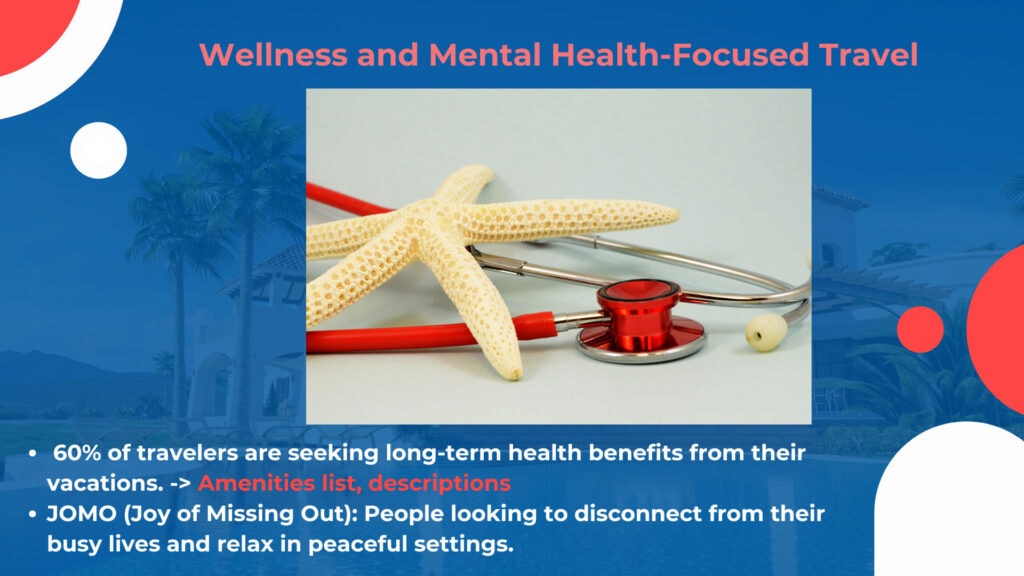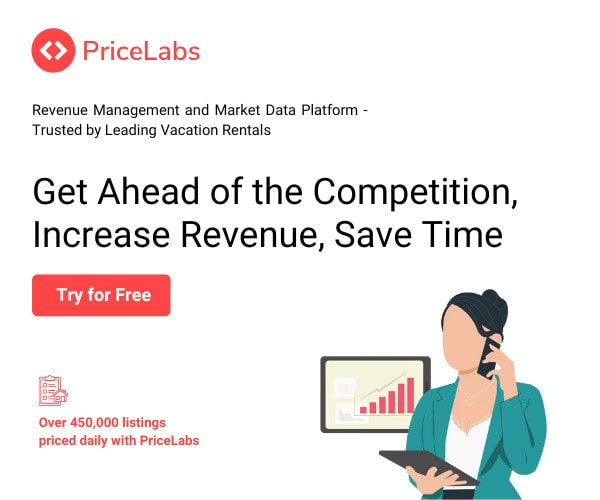2024 has been a whirlwind year for vacation rental managers—demand may be steady, but shrinking margins, tightening regulations, oversupply, and environmental risks have made profitability more elusive. As we approach 2025, these challenges aren’t going away, and new ones will emerge. But alongside these obstacles lie opportunities for those prepared to adapt.
These concerns set the stage for our most recent free webinar, for the first time in partnership with RevLabs – PriceLabs’ podcast chock full of revenue management insights.
From understanding what today’s travelers want to rethinking how you grow your inventory, our panelists shared actionable revenue management strategies to help you thrive in the year ahead. This article distills the key takeaways and strategies, so you can enter 2025 with clarity and confidence.
Meet the Experts
- Ben Coleman: Founder, Rev and Research – A consultancy focused on helping property managers maximize occupancy and optimize rates.
- Becca Madigan: Manager, Solutions Consultant at PriceLabs – With a background in coastal vacation rental operations, she now helps managers leverage PriceLabs tools for smarter revenue management.
- Richard Vaughton: Co-Founder, Yes Consulting – A seasoned expert in business expansion, mergers, acquisitions, and operational efficiencies for vacation rental managers.
- Thibault Mason: Founder, Rental Scale-Up and Head of Product Marketing, PriceLabs– An trusted industry analyst, Thibault draws on property management expertise and experience with travel giants like ebookers and Booking.com to offer insights on short-term rental market trends.
Spot Trends Early Using Your Own Data
In a year defined by uncertainty, understanding your portfolio’s performance is more important than ever. Rather than relying solely on external reports, digging into your own data can reveal actionable insights and help you stay ahead of market shifts. Here’s how:
Start with Pacing to Understand Performance
Pacing is one of the simplest and most effective ways to gauge performance. By comparing key metrics like revenue, occupancy, or ADR (average daily rate) year-over-year for the same date, you can quickly spot where you’re excelling—or falling behind.
Example: If your Florida properties generated $10,000 in October 2023 and $11,000 this October, you’re pacing 10% higher. But if revenue is down, use local market data to determine if it’s a broader trend (e.g., softer demand) or an issue specific to your portfolio (e.g., poor pricing or underperforming listings).
Segment Your Portfolio for Smarter Decisions
Not all properties perform the same way, and the Segment Occupancy Pacing Report in PriceLabs’ free Report Builder tool makes it easy to track trends across your portfolio.
This pre-set template organizes performance by key segments such as location, bedroom count, or property type (e.g., luxury villas, pet-friendly homes, or urban apartments). By analyzing this data, you can identify which segments are thriving and which may need adjustments.
Benefit: Instead of drowning in data, this report provides a clear picture of how different categories of your portfolio are performing. For example, if three-bedroom properties in urban locations are pacing below last year, you can investigate whether pricing, competition, or guest preferences are factors.
Don’t Overcomplicate It
With so much data available, it’s easy to overcomplicate analysis. Stay grounded by conducting a weekly review of core metrics—occupancy, booking pace, and ADR—from your PMS or tools like PriceLabs. If manual tracking feels overwhelming, consider outsourcing or using automated solutions to streamline your process.
Keep an Eye on Local and Industry News
Your internal data tells part of the story, but external factors also play a critical role. Local events, regulatory updates, and even changes in guest behavior can significantly impact bookings. Collaborate with destination marketing organizations (DMOs) or follow industry newsletters to stay in the loop. For example, knowing about an upcoming festival could guide you to adjust rates or minimum stays strategically.
Emerging 2025 Trends To Watch For
These trends based on recent reports by booking platforms like Booking.com and Expedia highlight what travelers are prioritizing in 2025 and how you can position your properties to meet their needs:
1. Shorter Booking Windows
The days of long lead times for vacation bookings are dwindling as guests increasingly plan their trips closer to their travel dates. To stay competitive:
- Price Inventory Realistically Further Out: Instead of holding out for “unicorn bookings” at peak prices, set attractive, bookable rates for dates months in advance to capture demand early.
- Adjust Minimum Stays During Shoulder Seasons: Shorter stays can fill gaps in occupancy when demand is lower, ensuring your portfolio remains profitable year-round.
2. Multigenerational Group Travel
Group travel isn’t new for the vacation rental industry, but OTAs like Airbnb and Booking.com are now stepping up their efforts to market to this segment, moving beyond Vrbo’s traditional dominance in the space. Features like group chat functionality and curated filters for larger properties signal this growing focus.
Boomers are leading the charge in multigenerational travel, not just planning trips but redefining what travel looks like later in life. According to Booking.com, 23% of Boomers are seeking thrill-seeking vacations in 2025, with activities like skydiving, canoeing, or glacier trekking gaining popularity.

Marketing Tips to Tap Into Multigenerational Travel Trend:
- Expand Beyond Accessibility: While features like single-story layouts or wheelchair-friendly amenities are essential, marketing should also reflect the adventurous spirit of this demographic. Use imagery and copy that highlights unique experiences near your properties—think hot air balloon rides, kayaking, or guided hiking tours.
- Think Past Vrbo: With OTAs like Airbnb and Booking.com rolling out new features to attract group travelers, ensure your property is optimized for these platforms. Update your listing to emphasize amenities like large communal spaces, family-friendly layouts, and group-friendly activities.
3. Wellness and Mental Health-Focused Travel
Wellness travel is on the rise, with 60% of travelers prioritizing long-term health benefits from their vacations. Whether it’s physical rejuvenation, mental clarity, or a chance to escape the pressures of daily life, guests are increasingly drawn to properties that offer more than just a place to stay.
The “Joy of Missing Out” (JOMO) is also shaping guest preferences. Travelers want peaceful settings where they can unplug, reset, and embrace simplicity. For property managers, this trend presents an opportunity to stand out by positioning your properties as restorative retreats.

How to Attract Wellness-Focused Travelers:
- Upgrade Your Amenities: Highlight features like blackout curtains, sound machines, ergonomic furniture, or spa-like bathrooms in your listings. Simple additions like yoga mats, meditation corners, or access to a private garden can resonate deeply with this audience.
- Curate Descriptions Thoughtfully: Use calming language in your listings to emphasize tranquility and relaxation. Phrases like “serene surroundings,” “unplug from the everyday,” or “reconnect with nature” can appeal to wellness seekers.
- Leverage JOMO in Marketing: Highlight quiet, peaceful aspects of your property, such as proximity to nature trails, scenic views, or spaces for stargazing. Avoid promoting busy sightseeing schedules or high-energy activities. Instead, focus on words and imagery that suggest slowing down, such as cozy interiors, morning coffee on a private balcony, or a firepit for unwinding at night.
- Tap into Local Wellness Attractions: Partner with nearby yoga studios, spas, or wellness-focused experiences to offer guests added value. These collaborations not only enhance the guest experience but can also be highlighted in your marketing.
4. Sensory-Friendly Accommodations
With 66% of neurodivergent travelers seeking accommodations that cater to their needs, the demand for sensory-friendly spaces is growing. Guests with neurological differences such as autism, ADHD, or sensory processing issues value environments that prioritize comfort and calm. For property managers, this represents a chance to appeal to an underserved market by making thoughtful updates to your properties and listings.

How to Cater to Sensory-Friendly Travelers:
- Update Amenities: Small changes can make a big difference. Consider adding noise-canceling machines, blackout curtains, dimmable lighting, and clear signage for navigation. A clutter-free design and neutral color palette can also contribute to a calming environment.
- Tailor Your PMS and OTA Listings: Include sensory-friendly amenities in your property management system (PMS) and on OTA platforms. Use language that highlights features like “quiet spaces,” “adjustable lighting,” or “peaceful surroundings.”
- Focus on Simplicity in Descriptions: Guests in this category often seek clarity and predictability. In your listings, avoid overwhelming travelers with too much information. Instead, provide concise, well-organized details about the property’s layout, accessibility, and features.
- Promote Inclusive Marketing: Ensure that your visuals and copy convey a welcoming, inclusive atmosphere. Highlight any nearby parks, calm natural spaces, or low-stimulation activities available in your area.
5. Set-Jetting
Pop culture continues to influence travel choices, with destinations featured in movies, TV shows, and on social media drawing in travelers eager to immerse themselves in their favorite stories. From visiting iconic filming locations to recreating memorable scenes, this trend has created new opportunities for vacation rental managers.
If your property is near a popular filming location or cultural hotspot, you can capitalize on this trend with tailored marketing and SEO strategies. Highlight these unique selling points in your listings and social media content to attract set-jetting travelers.
For a deeper dive into the set-jetting phenomenon and practical tips for leveraging it, check out our full article: How Netflix, Airbnb, and Social Media Are Driving the Set-Jetting Trend—and What It Means for Vacation Rental Managers

Airbnb’s Co-Host Network: Opportunity or Threat?
Airbnb’s newly launched Co-Host Network has sparked both curiosity and concern among professional property managers. Marketed as a way to “unlock millions more listings,” the program connects property owners with co-hosts who manage various aspects of hosting, from guest communication to cleaning and maintenance.
While the network promises growth potential, it also presents challenges for property management companies (PMCs).
Performance Comparison
Airbnb highlights that co-hosts boast an average guest rating of 4.86 stars, compared to 4.62 stars for large PMCs. However, this figure may reflect Airbnb’s selection criteria rather than an inherent advantage of co-hosting.
Unlocking Listings
Airbnb claims the program will unlock untapped supply, but there’s skepticism about the quality and revenue potential of these new listings. Early reports suggest many interested hosts have struggling or subpar properties that may not align with the goals of professional managers.
Lead Source or Competition?
For PMCs, the Co-Host Network could be a lead funnel, especially as inexperienced co-hosts grow their portfolios and seek professional support. However, the influx of co-hosts—over 20,000 sign-ups in the first two weeks—may also increase competition and further pressure margins.
Demand Uncertainty
While the number of co-host sign-ups has been impressive, Airbnb has yet to provide data on how many property owners are actively seeking co-hosts through the platform.
What Should Property Managers Do?
1. Differentiate Through Professionalism: Highlight your expertise, scalability, and proven ability to drive revenue for property owners. Position yourself as a professional alternative to less experienced co-hosts.
2. Evaluate Lead Potential: The Co-Host Network could serve as a valuable entry point for acquiring new properties. However, scrutinize the quality of these leads to ensure alignment with your portfolio’s standards and profitability goals.
3. Monitor the Impact on Margins: With Airbnb positioning co-hosts as a more affordable option, PMCs may face increased pricing pressure. Focus on delivering high-value services that justify your fees.
Conclusion
2025 will bring new challenges, but it also offers opportunities for managers who adapt. By leveraging your data, aligning with emerging guest preferences, and staying informed about shifts like Airbnb’s Co-Host Network, you can position your business for success.








